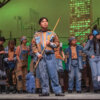This April, “Urinetown,” the Tony Award-winning Broadway musical, comes to Punahou’s stage. Theatre faculty members Melinda Moore, director, and Anna Foster, costume designer, give a behind-the-scenes look into the what goes into making the show a reality.

Director Melinda Moore is excited to bring this musical to the Punahou community, with its flashy dance numbers, catchy songs and thought-provoking lessons.
What was the inspiration behind choosing this show?
Despite the terrible title, this is one of my favorite musicals! “Urinetown” won tons of awards, three Tonys back in 2002, and is still produced by high schools, colleges and community theatre across the globe.
As a teacher and director, it checks so many boxes: lots of juicy parts for our budding actors, relevant storytelling, thought-provoking lessons, great dance numbers and catchy musical tunes.
It is a satire that makes fun of musicals themselves. Every musical number is a nod to another Broadway show! It keeps you on your toes and laughing the entire time. It’s ridiculous fun that makes us think a little deeper about the world around us, and I’m all about connecting the brain to joyful live entertainment!
What do you think audiences will take away from watching the show?
First, I hope they walk away being dazzled by our student performers. We have a large group of students who are new to the stage, and it’s really exciting to see them tackling such difficult material in a short time frame. For example, our lead, Preston, has never been in a show before! We also have some new performers from the Punahou Dance School, a slew of ninth graders, and even a few eighth graders joining us in featured roles!
Second, I hope the audience leaves thinking about the show and its deeper meanings about water rights, corporate greed and the fragility of our planet. It’s all in there, hidden between flashy dance numbers and toe-tapping music!
What was the biggest learning experience for the students who participated?
Because so many of our students are onstage for the first time all of it is a big, exciting and challenging learning experience. We’ve had to do a lot of fast-paced “acting 101” lessons to make sure every student has the basics of staging, character work and learning difficult music, and fast! We had about four weeks of rehearsal onstage and now leave for a two-week spring break without rehearsing together. When we come back from spring break, we only have a week before we open!
How many students were involved?
Over 50 students were involved in the production of the show, including 31 Academy actors, four eight grade actors and 20 Academy crew members.

The team has been hard at work since November crafting costumes to reflect the essence of the characters and show’s themes. As lead costume designer for the show, Anna Foster talks about her creative process.
Can you outline the process for coming up with the costumes?
The first step in costume design in theatre is analyzing the script. The script gives me information about time period, class and socio-economic status as well as how many people are in each scene.
After that, I talk with the director to hear their vision for the play. Since this musical deals with the dichotomy between the super poor and super rich, I decided to borrow some of the aesthetic from the “Hunger Games” series where the rich take all style choices over the top and their fashion and lifestyles are extremely wasteful.
The musical also deals with a lack of resources, so I decided to make the costumes from donated recycled materials. I research and search for images similar to what I hope to make and construct a Pinterest board to hold my ideas. I then draw the costumes or I do a collage of inspiration pictures.
Why are costumes so important to storytelling?
The costumes give the audience information about the characters without having to explicitly lecture the audience on time period, class and occupation, and they also link characters together through color, texture and silhouette.
We’ve created one-of-a-kind pieces from upcycled materials to highlight the differences of the two socioeconomic groups. Disposal items get a new life in the costumes of the poor, while an excess of recycled materials makes up the costumes of the rich – demonstrating how recycling can be for show rather than an effective use of resources.
From concept to finish, how long does it take to do the costumes?
I started working on the concepts for “Urinetown” in November since we commit all of December and January to Carnival’s Variety Show. We began building costumes a week after Variety Show in February. All costumes need to be done before spring break, which means we had five weeks to build the costumes.
For a show like this, the costumes are extremely labor intensive, and their overall look is largely determined by the donations we receive. Five weeks is a really short time to complete a highly conceptual and creative design – it couldn’t be achieved without a lot of help.
How many people are involved in creating costumes?
We have a staff of three in the costume shop so none of this would be possible without volunteers. So far, we have had 30 adult volunteers of all skill levels who come from Punahou staff, alumni, parents of actors in the production, and the community. We have open shop hours on Wednesdays for students to volunteer as well, and we have had 14 students from both the middle school and the Academy do costume work for this show. One longtime student volunteer, Riyo Williams ’25, is including the costume she’s designing in her AP Art portfolio. We are so happy to provide students interested in design with opportunities as they develop their skills and interest in theatre.






